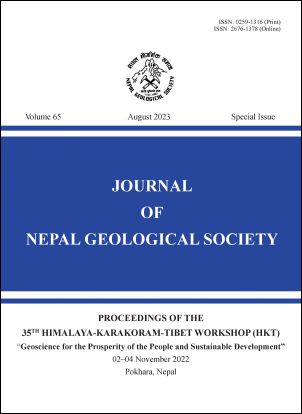Hydrogeological study along Marsyangdi River terraces: A case study in Lamjung, Tanahun and Gorkha districts
DOI:
https://doi.org/10.3126/jngs.v65i01.57771Keywords:
Groundwater, Marsyangdi terrace, geophysical survey, deep tube wellAbstract
Groundwater, one of the major natural resources of Nepal, is widely used in supplying domestic water and irrigation across the nation. Hand pumps and tube wells are used in the Terai area for the groundwater while in hilly and mountain regions, springs serve as the primary groundwater sources. However, there has been limited studies and investigations related to groundwater in hilly areas, making it difficult for study of groundwater potential and occurrence. In this study, the hydrogeological study has been carried out in the terraces formed by the Marsyangdi River for investigating the groundwater potential of the particular area. The study uses the geophysical survey data of vertical electrical sounding (VES) and associated electrical resistivity tomography (ERT) and drilling data from deep tube-wells established within the study area.
The study reveals that the study area possesses noteworthy groundwater potentials in the Harrabot and Garambesi of Lamjung, Kalimati and Khaharephant of Tanahun and Ranitar and Chyanglitar of Gorkha Districts respectively. The discharge rates of these seven tube wells ranges from 3.33 to 13.8 lps showing low to high groundwater potential in these areas. The lithology extracted from the drilling samples predominantly reveals clay, silty clay with gravel cuttings and sand materials with fractured rocks which are considered to be suitable zone for aquifers formation. The major sources of groundwater recharge in these areas could be rainfall infiltration and Marsyangdi river flow. This study shows that these deep tube-wells can be a good groundwater sources for domestic and irrigation purposes and those insights gained from this research will be useful in further groundwater exploration efforts in different areas of the hilly regions comprising of similar geology, spring distribution and geomorphology.
Downloads
Downloads
Published
How to Cite
Issue
Section
License
© Nepal Geological Society




